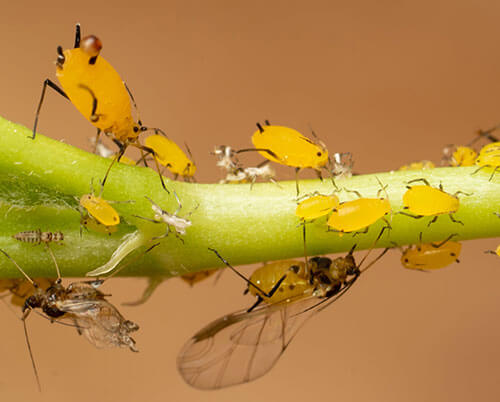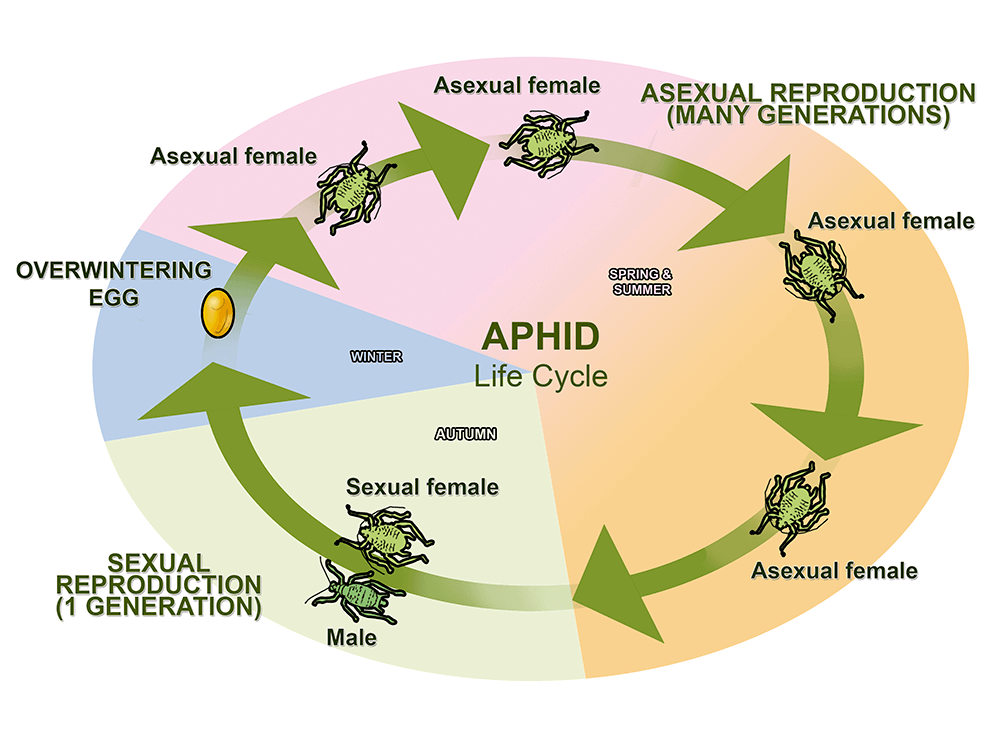Whether you are growing field crops, have a home garden, or have ornamental plants around your home, aphids are a pest for so many reasons!
- They transmit viruses from one plant to another.
- They weaken the plants by sucking sap from them.
- They cause other diseases, like sooty molds, to grow due to the sticky sugary honeydew poo they leave on the plants.
- They inadvertently invite other pests, like ants, to come “farm” them to feed on their sweet honeydew poo.
Identification
Aphids are very small soft bodied roundish or pear-shaped insects with two “tail pipes” sticking out their backside called cornicles. They have piercing/sucking mouthparts. They can be winged or wingless within the same species and population depending on the time of year, and environmental conditions. They also come in a variety of colors.


Biology & Behavior
Aphids overwinter as eggs and in the spring the female that hatches out is called the fundatrix or stem mother. This female aphid reproduces asexually (without males) and several generations reproduce this way through the spring and summer.
In the fall both males and females are produced. The females are fertilized by the males, then go on to lay the overwintering egg.
Although not pictured in the life cycle image below, aphids can also produce winged phenotypes. This is usually triggered when a plant becomes overcrowded and winged types are produced that can migrate to other host plants.
Aphids can produce multiple generations per year, which can cause very quick explosions in population leading to severe damage to plants.

Aphid Management Options
Aphids are difficult pests to control, but there are multiple options for management. Insecticidal compounds (including soaps, organic products, botanically based, and synthetic), parasitoids, predators, and entomopathogenic fungi are all common options for aphid management.
Insecticidal Compounds
First let’s talk about the insecticidal compounds. Insecticidal soaps can work well, but they can also cause phytotoxicity (leaf burn) on sensitive plants.
 In the United States, organic pesticides can be OMRI listed, which means they meet NOP requirements for organic production. Look for this logo on the product to make sure it is acceptable for organic use.
In the United States, organic pesticides can be OMRI listed, which means they meet NOP requirements for organic production. Look for this logo on the product to make sure it is acceptable for organic use.
MGK has several products that are OMRI listed and meet NOP standards, including Debug®, Pyganic® and Evergreen® Concentrate.
We have tested them for phytotoxicity, and they are much less likely to cause leaf burn than insecticidal soaps, except in rare instances. Make sure to test a small area and observe the plants for a few days before applying the product to the entire crop or garden. This is a best practice for any insecticidal application as different species or cultivars can have different sensitivities.
Check out the table below to see which MGK product meets your specific needs.
| Product Name | Active Ingredients % | Intended Use |
| Pyganic 1.4 | 1.4% Pyrethrins | Commercial Outdoor Crop |
| Pyganic 5.0 | 5.0% Pyrethrins | Commercial Outdoor Crop |
| Pyganic Specialty | 5.0% Pyrethrins | Greenhouse Commercial Outdoor Crop |
| Evergreen Pyrethrum Concentrate | 5.0% Pyrethrins | Greenhouse Commercial Outdoor Crop, including post harvest |
| Debug Trés | 3% Azadirachtin 4.7% Neem Oil |
Greenhouse Commercial Outdoor Crop |
| Debug Turbo | 0.7% Azadirachtin 65.8% Neem Oil |
Greenhouse Commercial Outdoor Crop |
| Debug Optimo | 0.7% Azadirachtin 15% Neem Oil |
Greenhouse Commercial Outdoor Crop |
| Debug ON | 70% Neem Oil | Greenhouse Commercial Outdoor Crop |
| Pyganic Gardening | 1.4% Pyrethrins | Home Gardening |
Please see label for specific use directions
MGK does not sell synthetic crop and garden insecticides, but they are common and easy to find. This type of application is generally called conventional control.
Parasitoids & Predators
Next, we have parasitoids and predators. Predators like lady beetles will directly consume the aphids.
Parasitoids are often tiny wasps, occasionally flies, whose larvae develop inside the host and eventually kill it. These are generally not used on large scale outdoor crops because they are too costly.
They can be used in home gardens if the gardener can manage the costs. Home gardens are generally not grown for economic purposes, but more as a hobby.
Commercial greenhouses often use parasites and predators successfully and economically. The controlled environment can reduce the losses of parasites and predators. Greenhouses can keep parasites and predators from simply leaving, as well as reduce natural occurrences such as environmental conditions, pathogens, and other parasitoids and predators that would harm them.
Entomopathic Fungi
Entomopathogenic fungi are the last management topic. Beauvaria bassiana and Metahrizium anisopliae are common fungi used for aphid management. The fungi will attach to and grow on the aphids and often other insects, piercing their exoskeleton and eventually killing them. They can be applied like a conventional insecticide, most often as a granular or mixed in a liquid solution. Note that if the fungi are not species specific to the pest, they will negatively affect any susceptible insects in the area, including beneficials.
Using Multiple Control Methods
With all these options for aphid management, it is important to note that many of these methods can and will interact with each other.
Make sure you aren’t using multiple methods together that could reduce effectiveness. For example, applying a parasitoid and an entomopathogenic fungi together would cause the fungi to attack both the parasitoid intended for control, as well as the aphids, if the fungi are not species specific to the pest.
On that note, pyrethrins have a half-life of about 11 hours in direct sunlight and azadirachtin lasts a little longer, maybe a few days. Once those active ingredients have degraded, they will not affect parasitoids, predators, or pathogens.
See MGK products approved for use in organic production and gardening

